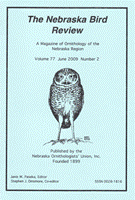Nebraska Ornithologists' Union

Nebraska Bird Review
Date of this Version
9-2024
Document Type
Article
Citation
Nebraska Bird Review, volume 92, number 3, September 2024, pp. 102–127
Abstract
This was an intriguing summer in several ways. I am far from being a knowledgeable ecologist, but, like most of us, as a layman I wonder whether and how weather affects birds, and if and how local weather is reflecting the conventional wisdom of climate change. Climate change seems increasingly to be expressed as various extreme or rapidly changing weather events that have differing effects on vegetation and consequently insect and larger prey populations. Every species responds differently it seems, depending on its biological needs, but food supply is the most important issue for birds. It is tempting to assign causes to observed changes in bird movements and distribution, but in a Seasonal Report like this, we can only attempt to discern and summarize patterns that might be amenable to further detailed inquiry. An online search will locate numerous articles on this topic.
Overall, it seems water conditions might have been an overarching influence on these patterns. There is a stark difference indicated by Nebraska drought maps (https://nda.nebraska.gov/drought/index.html) between 4 Jul 2023, when most of Nebraska was under “severe to exceptional drought”, and 2 Jul 2024, when most of the state was drought free. The Panhandle, however, largely escaped the 2023 drought conditions, which may explain increased reports of certain species there.
Summer vagrant waterfowl and paused-migration shorebirds were found more often than usual, possibly a result of several late spring and early fall migrants and more paused-migration shorebirds crowding into the Jun–Jul period as a response to better water conditions than in 2023.
Prominent among summer waterfowl were Green-winged Teal, four Aythya diving ducks, Bufflehead, two mergansers, and Ruddy Duck. Surprising were rare summer reports of Surf Scoter and Horned Grebe.
At least nine shorebird species were reported from mid-Jun through mid-Jul, many of these late or early migrants, but some more likely immature non-breeders that paused a half-hearted northward migration.
Increasing reports of certain limited range breeders are perhaps of most interest as possible indicators of weather and/or climate effects. There were several, each with unique characteristics. Most intriguing were the 11 reports of Black-billed Cuckoo, almost four times the yearly average for the last 10 years. Also important were new sites and increasing reports from traditional breeding sites for Mississippi Kite, good numbers of Short-eared Owls in the Panhandle, continuing reports of Common Raven and possible breeding in the Panhandle, wide-ranging Jun–Jul distribution of Red-breasted Nuthatch away from expected breeding areas, and increasing reports of Gray Catbird, Bobolink, and Baltimore Oriole in the Panhandle, perhaps expected in consecutive drought-free years.
Quite concerning was the absence or nearly so of a few Nebraska breeders. Gray Partridge may be under some pressure; the only report was from the western edge of its range. Strangely, there have been no reports of Pinyon Jay since October 2023, perhaps merely a cyclical phenomenon for this erratic species. There were no reports of Dark-eyed (White-winged) Junco, usually a rare Pine Ridge breeder; most recent reports appear to be of migrants. Henslow’s Sparrow was unreported; it is tempting to assign drought effects on grasslands and consequent overgrazing as a cause, although this species sometimes reoccurs in August aggregations at favored locations; we will see how August shakes out.
Rare summer occurrences of enigmatic Nebraska breeders may be unrelated to each other but taken together may indicate some aspect of climate influence. Notable were a first summer record of Western Red-tailed Hawk (Buteo jamaicensis calurus), continuing Ash-throated Flycatcher, enigmatic reports of Sage Thrasher, and Clay-colored Sparrow, which was the first Nebraska Jul record and 3rd of a singing male. Of further interest regarding breeding status were tantalizing observations of Black-chinned and Broad-tailed Hummingbirds that invoked the possibility of nesting, not yet known for the state. Similarly, reports of fresh juveniles in summering flocks of Red Crossbill suggest but do not confirm Nebraska breeding. Exciting was nesting of Red-shouldered Hawk and Peregrine Falcon, the former one of few recent documented records and the latter the first at the Capitol Building in Lincoln since 2016; intriguingly, both nestings apparently involved yearling females paired with older males.
Possible range expansion of breeders within Nebraska is suggested by territorial Least Flycatchers in the North Platte River Valley in Garden Co, occurrence in Scottsbluff of western subspecies Vireo gilvus brewsteri of Warbling Vireo suggestive of nesting, which is unknown away from the Pine Ridge, a count of eight Pygmy Nuthatches at the limber pine area near Pine Bluffs, and 2nd and 3rd reports of Northern Cardinal at Alliance.
Notable northerly reports were of Northern Mockingbird and Cassin’s Sparrow. Westerly reports included a documented nesting of Ruby-throated Hummingbird at Valentine, Cherry Co, Carolina Wrens in Keith and Kimball Cos, 4th and 5th Eastern Bluebird reports at Crescent Lake NWR, and Northern Parulas at Lake McConaughy. Easterly were the 4th Keith Co record of Dusky Flycatcher and an interesting successful nesting by a pair of hybrid orioles near Valentine.
Record late spring migrants included Alder Flycatcher and, 2nd latest on record, a singing Veery.
Unexpected high counts included the 12 immature Lesser Black-backed Gulls at Lake McConaughy and 10,000 Bank Swallows at Crescent Lake NWR.
Included in
Ornithology Commons, Population Biology Commons, Poultry or Avian Science Commons, Zoology Commons


Comments
Published by the Nebraska Ornithologists’ Union, Inc.